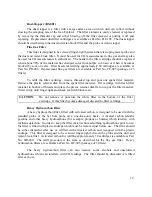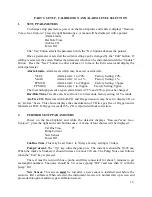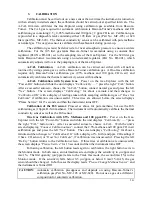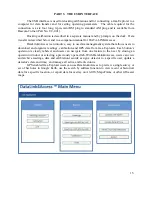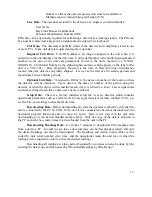
2.
ESSENTIAL OPERATING PRACTICE
Gas-Explorer detectors are easy to use. A detector is turned on by pressing the left button;
its operation is controlled by three
“Soft”
buttons whose function is shown on the display. The
middle button toggles
“Mute”
on and off in the Track Gas mode (see later). Double-clicking the
middle button turns the backlight continuously ON, or OFF depending on its previous state.
Once the appropriate display is selected, operation is automatic. However, a few general rules
must be followed to insure reliability.
Pump.
Gas-Explorer detectors have a built-in pump and depend on this pump for their
operation. If the pump is not functioning normally, the instrument will not function properly. It
is therefore essential to check the pump each time the instrument is turned on.
Pump Test:
Connect the probe you plan to use and turn the instrument on. After the
display shows “
Block Intake
”, block the probe tip with your finger to show
"Pump OK"
.
If
"Pump OK"
does not appear, tighten all connections and repeat the test. If a block
condition is still not observed, remove the probe and block directly the inlet to the instrument. If
"Pump OK"
still does not appear, return the instrument for repair.
A pump test can be carried out as above at any time during normal operation. If there is
any indication that the pump is not operating normally, return the instrument for repair.
Filters.
Dust and water-block filters protect the sensors and the pump from dust and
accidental intake of liquid water. Just as a car would not be operated without air and fuel filters,
do not operate a detector without a filter on the probe.
Operation without this filter will
eventually degrade the natural gas sensor and the pump. It also voids the limited warranty.
Filters are available from Bascom-Turner in packages of five, Part No. WF-505 for all models
except WF-705 for EGA-611/612.
Zero Check.
All sensors drift to some extent over time. Sensor drift is automatically
corrected by zeroing if the drift is within 0.1% vol. GAS (and 10ppm CO if the unit is equipped
with a CO sensor). If the drift is outside this limit, “
NO GO
” is displayed and the user is asked
to autozero the unit in “clean” outdoor air. The user can override this limit and re-zero the
instrument unless the zero has drifted over 1.0% vol. GAS, in which case the instrument should
be checked by a trained professional (the sensor may need replacement). It is important that the
zero adjustment be done in clean air, for example, outdoors. If the sampled gas is not clean, a
systematic error may be introduced in subsequent measurements.
WARNING:
On a call, turn the instrument on outdoors, not indoors.
Test and Calibration.
Gas-Explorer detectors must be checked and calibrated
periodically with gas of known composition. The catalytic combustion, carbon monoxide, and
hydrogen sulfide sensors depend on catalysts which may loose activity or get poisoned during
use. When this happens, there will be diminished response.
The necessary frequency of calibration depends on actual use and on the concentration of
catalyst poisons in the sampled gas. This concentration is, or course, not generally known.
A detector can be tested with "bump" gas. Such tests verify that the gas sensor(s) are in
operating condition. To verify and adjust, if necessary, their sensitivity they must be calibrated.
A detector can be automatically calibrated in approximately one minute using Bascom-
Turner's calibration gas (2.5% CH
4
and 100 ppm CO in air). Given the ease and speed of
automatic calibration, it pays to calibrate as frequently as possible, and certainly, no less than
monthly.
2.

















